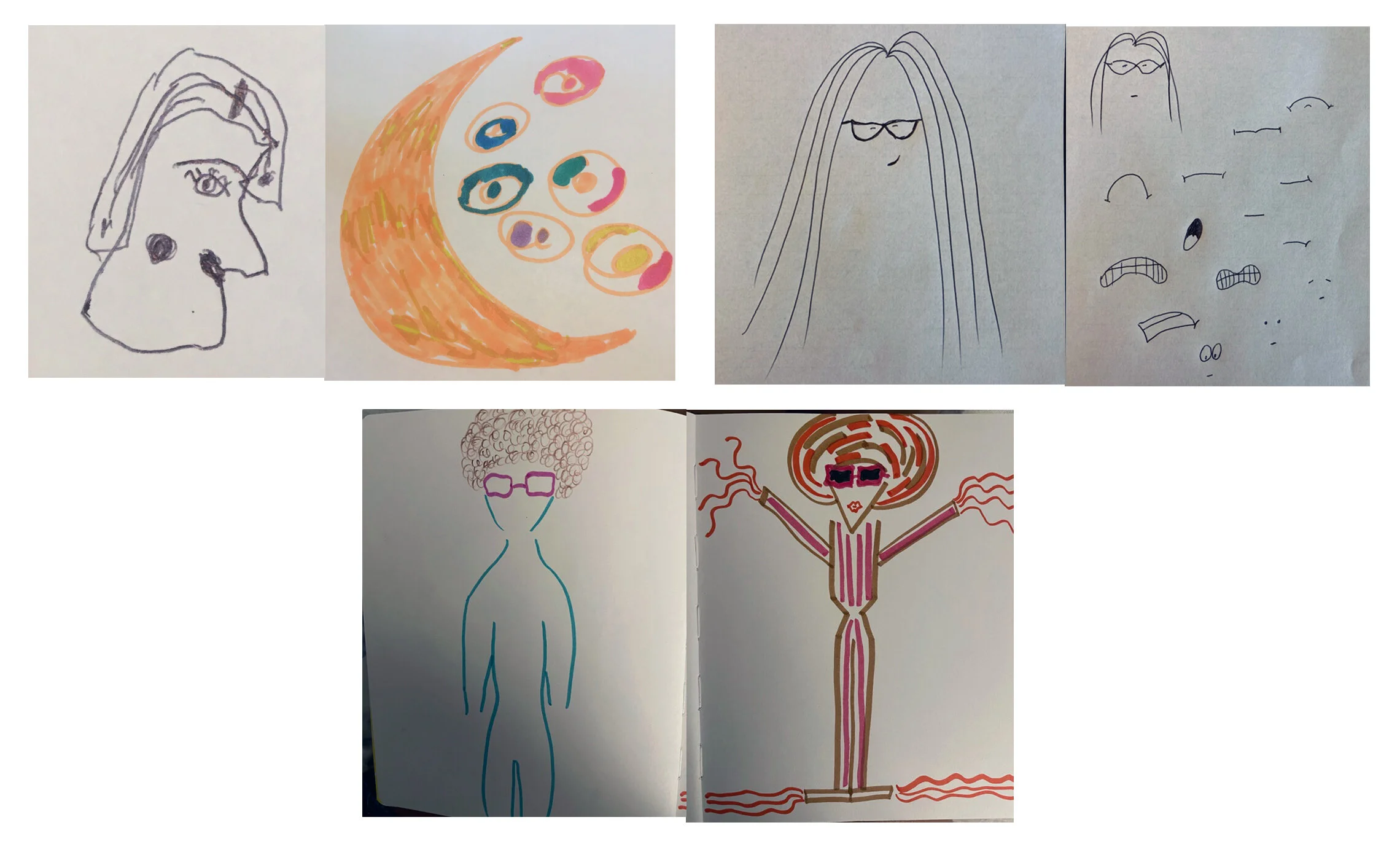How do we share our creations which embody meaningful parts of who we are with others when there is always a chance that it will not be received in nurturing ways? How do we become more brave in this process and make some noise no matter who sees it?
What Are the Rules?
Building Authentic Creative Communities
Artwork and Reflection by Sebila Kratovac
Living in New York City throughout my 20s, I became disillusioned with what it means to belong to a creative community. As an artist and a creative, I tried to figure out how to make artist friends without success. Either I wasn’t “cool” enough, self-destructive enough, or technically skilled enough to find the right fit for me so I developed a negative view of artist communities in general. My perceived failure to belong to a creative community in NYC planted a seed of unworthiness into my subconscious, a self-sabotaging belief that I somehow would never belong to anything just the way I am.
The fact that many artists, including me, are introverts, at least most of the time, led me on a path of isolation, loneliness, and stuckness. I am still on this journey of finding my “tribe” and have recently come across very informative YouTube vlogs (4 Ways to Build Creative Community and How I Built a Creative Community That Kicked Off My Creative Career) by Tom Froese, a very talented illustrator and educator. In his story-infused videos, Froese talks about how he brought himself out of depression by building a creative community around him before the days of social media. He mentions ways in which he connected with other creatives, initiating relationships that helped him become more confident and inspired to pursue an illustration career. But how does an introvert with limiting beliefs become a creative community builder?
Froese describes how his yearning for being seen and appreciated for who he is became a strong motivation for him to share his art. He started with blogging - sharing his thoughts, song lyrics, digital photography, and other creations. Once he gained a following, he slowly developed confidence and created his own meetup group Creative Breakfast. Taking a small step such as sharing our art on Instagram so that people can find us can be a powerful catalyst for getting unstuck. This way, we can attract an audience and can get our followers involved with our creative process. For example, Froese started posting illustrations of noses on Instagram every day for 100 days under the hashtag #the100dayproject. As he received more interest in his art, he began engaging with his followers by commenting on their posts and leaving positive feedback, as well as answering all their questions. Social media can be a great tool to attract people who match our interests and many people who meet through social media go on to start online communities through Zoom and other digital platforms.
This amount of online engagement can seem intimidating and exposing to a lot of introverts and I have found myself coming in and out of social media when it begins to feel too overwhelming for me. But, luckily, there are many alternative ways to engage with other creatives. If you are more comfortable connecting with others in person, you can create a workshop, a meetup group, or an event such as a dance party or a potluck where creatives with similar interests and values can come together. Froese talks about going to conferences for creatives where he made many personal and business connections. From my own experience, taking a course or pursuing further education in a desired creative field will automatically give you access to other creatives, feedback, and mentorship. You can also seek out mentorship outside of academia so don’t be afraid to reach out to more experienced creatives for help.
What if there aren’t many physical opportunities to meet creatives in your area? Since big cities are becoming too expensive for artists, Froese suggests to search online for smaller, more affordable towns with burgeoning artist communities and see if moving to one of them is a good choice for you. If moving is not possible, collaborating with other creatives remotely could be a good way to create deeper relationships with others. Collaborations are also a great way to get inspired, learn from others, get feedback, or just to be held accountable for creating new artwork.
How can we make the first step to put ourselves out there? What has helped me is to make peace with my discomfort in certain social situations. It is okay to feel anxious, slow to trust, or uncertain about how to create boundaries with people. But, since most of us, introverts included, want to connect with others - to be seen and heard – we can take small steps toward connecting with others, even if it seems uncomfortable in the beginning. To make the process less stressful, we can think about how we want to feel around people we want to connect with and imagine we are already surrounded by our tribe. We can pay attention to how we feel when we meet people and ask ourselves “Do I feel good around this person or am I pursuing this relationship because I feel lonely?” Most of us have a desire to belong, but at what price? One of Froese’s greatest takeaways is that the best way to become unstuck and authentically connect with others is to build our own creative communities, on our own terms. This way, we can attract people to us through freely sharing who we are, be it by writing a blog or posting our artwork. Connecting with people takes vulnerability and an open heart ready to risk disappointment. As long as we can cultivate courage and healthy boundaries (this comes with life experience), as well as patience for authentic connection, we will eventually find what we are looking for and thrive.
How to Step Into the Unknown
Reflection and Artwork by Sebila Kratovac
Embarking on a creative journey is kind of like going on a hero’s journey – it is a feat of trial and error, fear, confusion, resistance, slaying inner demons, and feeling lost. But, there are rewards on the other side, gifts from the universe once we do the necessary work to overcome what is preventing us from creating authentically on our own terms. I recently listened to a wonderful Creative Peptalk podcast episode called Your Creative Center: How to Find It and Create from It with Johnny Pemberton, which inspired me to talk about some of the ways we can begin this daunting journey.
In many cases, we are afraid to start our creative journey based on limiting beliefs of unworthiness, lack of talent, or that we have nothing unique to offer to the world. Other reasons we feel stuck and resistant might be related to our fear of the unknown or of doing something that is out of our comfort zone. The hardest thing may be to make that first step but how and where do we start? As Joseph Campbell once said, “Just dive in!”. We can start by finding a first step that feels the easiest for us to make. For example, in the book The Artist’s Way, Julia Cameron talks about encouraging her clients to commit to writing morning pages, three page stream-of-consciousness writings completed every single morning before anything else is done. Activities like Cameron’s morning pages, freestyle dancing, or doodling that suspend our judgement and our tendency to plan are very effective in freeing the mind from the left brain box and releasing our fear of doing something in the “wrong way.”
After making the first step to ease a bit of our fear and resistance, we can then feel freer to explore and gain some life experience, which is priceless for teaching us more about who we are and what makes us light up. There may be times when we follow a direction which, in the end, will not feel right to us but we are always free to change our course. Through our life experiences, pivoting as we go, our inner compass will be refined, clearing our way from distractions to our true North.
Once we find something that is dear to our heart, the trick is to focus all our energy into that creative activity. Let’s say we figure out that we want to illustrate children’s books but getting a job as an illustrator with a big publishing company seems like a far-away dream. What we can do is seek out people who have written a children’s book and would like to have it illustrated or we can illustrate our own book! This may be a path of less resistance where we can gain more experience and confidence which can prepare us for bigger, more competitive projects.
Fully engaging in something we love, something that feels authentic and nourishes our soul, can lead us to experiencing the flow state – a place where time is suspended and energy is limitless. The more we create in this flow state, the more we can perfect our craft and gain confidence to show our work to others. Our authentic voice will inevitably shine through. We won’t have to look for our creative specialty or style - it will find us.
There isn’t necessarily a milestone or a destination that we have to reach on our journey. For me, the creative journey is about getting to know myself and making choices that feel better and are more aligned. These gifts of clarity and purpose may be even more valuable to us than reaching a particular goal. Our journey never truly ends because humans have this innate drive to grow, expand, and create. So why not make our creative journey an exercise in what is possible and also enjoy the discoveries along the way?





